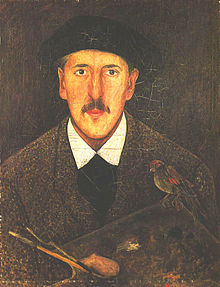Tadeusz Makowski
Tadeusz Makowski (born January 29, 1882 in Oświęcim , † November 1, 1932 in Paris ) was a Polish painter.
From 1902–1906 he studied classical and Polish philology at the Jagiellonian University in Cracow, 1903–1908 painting at the Academy of Fine Arts in Cracow under Jan Stanisławski and Józef Mehoffer .
In 1908/1909 he came to Paris, where he stayed until the end of his life. In Paris he first painted under the influence of the frescoes by Pierre Puvis de Chavannes , and later turned to Cubism. At the invitation of Władysław Ślewiński , he spent the time of the First World War in Brittany , which he later visited often.
Since then he has rejected cubism and returned to studying nature. He painted landscapes and figures in the spirit of naive realism. In his works, influences of old Dutch masters and the painting of amateur artists were noticeable. He painted stylized children, scenes from life in the country, carnival scenes and masquerades on wooden dolls. He also dealt with the woodcut. He kept a diary from 1912 to 1931.
His last works are among his most important pictures: "The Shoemaker" and "The Miser".
literature
- S. Ledóchowski, Tadeusz Makowski , Krajowa Agencja Wydawnicza, Warsaw 1984, ISBN 8303001485
- Exhibition catalog: Museum Bochum / Muzeum Narodwe w Warszawie; Tadeusz Makowski 1882 - 1932 , introduction: Peter Spielmann, 1990 ISBN 3-8093-0150-7
| personal data | |
|---|---|
| SURNAME | Makowski, Tadeusz |
| BRIEF DESCRIPTION | Polish painter |
| DATE OF BIRTH | January 29, 1882 |
| PLACE OF BIRTH | Oświęcim (Poland) |
| DATE OF DEATH | November 1, 1932 |
| Place of death | Paris |


